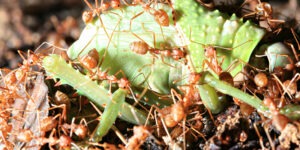What Are Fire Ants?
Fire ants are at best a nuisance, and at worst a threat to your family and pets. These insects often have an aggressive nature and can attack people and animals alike, inflicting highly painful stings. The weather conditions in the Carolinas serve as an ideal environment for fire ants to thrive, making it crucial that you stay vigilant and take preventative action to protect your property from infestations.
How Can I Identify Fire Ants?
The fire ant typically lives in open areas and fields. They are a reddish-brown color with antennae and have a painful sting. Fire ants grow to anywhere from 1/8 to 3/8 of an inch. Most people recognize a mound before spotting the fire ants themselves. These mounds often reach a height of 24 inches. Fire ants may build mounds near logs, tree stumps, or even under buildings. They prefer to use soil from sunny areas, so most colonies are found in the open and not in heavy forests or vegetation.
Colonies consist of a queen that lives between two to six years and workers with a life span of around six months. It takes around three years for a colony to become established and mature. The queen has wings and mates while in flight. During these mating flights, fire ants can travel up to 12 miles. This contributes to the spread of these pests. They also travel to new areas by hitching a ride on a vehicle.

Are There Different Types of Fire Ants?
There are two main categories of fire ants living in the United States. These are imported fire ants and native fire ants.
Imported Fire Ants
The most common species of imported fire ant is Solenopsis invicta. It’s also called RIFA (Red Imported Fire Ant) and was introduced to the U.S. by accident around 1933 when it entered through ports at Pensacola, Florida, and Mobile, Alabama.
These ants pose the biggest health threat. They are aggressive, adapt easily to temperature and weather changes, have few predators, reproduce quickly, and deliver a painful bite. RIFA often displaces other species of ant, but effective control measures can help to eliminate populations.
Native Fire Ants
The Bite of native fire ants is also painful, but these species are less aggressive than imported fire ants. Several species live in the U.S., three of which call North and South Carolina home:
- Native Southern Fire Ants (Solenopsis xyloni)
- Tropical Fire Ants (Solenopsis geminata)
- Little Fire Ants (Wasmannia auropunctata)
No matter what species of fire ants you have, it’s important to call a professional exterminator to eliminate the population as soon as possible.
Are Fire Ants Dangerous?
The fire ant can wreak havoc on lawns and landscaping. They build their nests in the ground and create raised hills of dirt that can grow into large mounds, which may cause considerable damage. Mounds in fields can damage farm equipment and prevent workers from harvesting crops. Fire ants rarely go indoors, but they can enter through gaps and cracks around windows and doors, or the HVAC and air conditioning systems. When they do find their way inside, they can cause electrical fires by damaging wires.
The main threat of fire ants is their aggressive nature and painful bite. Fire ants are potentially dangerous for medical reasons. Most fire ant bites cause discomfort like itching and burning and leave behind red bumps that may cause permanent scars if you scratch the bite. White pustules appear at the site of the ant bite and take around a week to heal. Minor bites generally require home treatment, such as applying cold compresses to stop swelling, antibiotic cream to prevent infection, and hydrocortisone cream to stop the itch. Over-the-counter antihistamines can also help, but you should first ask the advice of a doctor if you experience any symptoms of an allergic reaction.
Serious complications can arise in some cases, leading to severe injuries or fatalities. People with an allergy to fire ant venom can go into anaphylactic shock after getting stung. Symptoms of a fire ant sting that require medical attention include severe itching, nausea, and sweating. You should also seek advice and treatment from a medical professional for a bit that doesn’t heal within a week.
The most serious threat is getting attacked by a fire ant colony. Populations can grow to 500,000 ants, leaving the victim open to multiple bites, which increases exposure to the venom and the risk of having a serious reaction.
How Can I Prevent an Infestation?
Fire ant control measures are often difficult and require professional intervention. However, you can take steps to prevent an infestation before it begins by following these tips:
- Prune trees and shrubs.
- Clear your outdoor spaces of leaf piles, grass clippings, and other yard refuse.
- Pick up fallen fruit if you have fruit trees.
- Turn mulch every two weeks to discourage ant nests.
- Seal cracks and gaps in your buildings to prevent fire ants from going inside.
- Clear away trash and keep it in sealed containers.
These basic measures help to keep fire ants, and many other bothersome pest species, away from your home or business.
How Can I Get Rid of Fire Ants?
One of the challenges of fire ant control is that colonies grow quickly, and large mounds have more than one queen. If you manage to kill one or two queens, another can take its place and help the colony recover and continue to thrive. The best approach is targeted, expert treatment from professional pest control technicians.
When to Call a Fire Ant Exterminator
Attempts to control fire ants on your own often prove ineffective. For the best results, you need the assistance of an expert. Killingsworth Environmental provides quality, state-of-the-art pest management service for fire ants in the Carolinas. Our team has the skill and experience necessary to inspect your property and create a customized plan to eliminate fire ants. Contact us today to get a free quote or schedule your services.
Fire Ant FAQs
Queens live between two and six years, while workers can live up to six months. It takes an average of three years for a mature colony to develop.
Fire ants spread during their mating ritual habits. Winged queens can travel up to 12 miles looking for mates. They also sometimes travel to new places after resting on trains, cars, and trucks.
People with allergies to fire ants can face serious injuries from a fire ant bite. Anaphylactic shock, a life-threatening reaction, is possible in rare cases. Seek immediate medical attention if you experience any severe symptoms including difficulty breathing, trouble swallowing, severe swelling, intense itching, nausea, or sweating. Minor reactions are treatable at home with hydrocortisone cream, antibiotic cream, and antihistamines. See a doctor if your fire ant bite doesn’t heal within a week.
Fire ants originated from Brazil in South America. They are an invasive species introduced to the United States by accident.
Fire ants differ from other species because they can sting as well as bite. They look different because fire ants have two bumps on the waist section of the body between the thorax and abdomen. These insects are also much more aggressive than other ant species. They tend to swarm if their mound gets disturbed.

